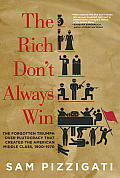 George Santayana famously said “Those who forget history are condemned to repeat it.” But what about those who never learn history? The history of Labor in this country is shamefully overlooked in our schools and media, but our friends at KBOO sent us a book that fills in much of the missing parts. Compared to Zinn’s People’s History of the United States, it tells the story of the rise and fall of the middle class, and explains why it won’t get better until we learn to respect labor appropriately. Just click the links to go to the Powell’s website for the book.
George Santayana famously said “Those who forget history are condemned to repeat it.” But what about those who never learn history? The history of Labor in this country is shamefully overlooked in our schools and media, but our friends at KBOO sent us a book that fills in much of the missing parts. Compared to Zinn’s People’s History of the United States, it tells the story of the rise and fall of the middle class, and explains why it won’t get better until we learn to respect labor appropriately. Just click the links to go to the Powell’s website for the book.
“The Rich Don’t Always Win” by Sam Pizzigati
 The Occupy Wall Street protests have captured America’s political imagination. Polls show that two-thirds of the nation now believe that America’s enormous wealth ought to be “distributed more evenly.” However, almost as many Americans–well over half–feel the protests will ultimately have “little impact” on inequality in America. What explains this disconnect? Most Americans have resigned themselves to believing that the rich simply always get their way.
The Occupy Wall Street protests have captured America’s political imagination. Polls show that two-thirds of the nation now believe that America’s enormous wealth ought to be “distributed more evenly.” However, almost as many Americans–well over half–feel the protests will ultimately have “little impact” on inequality in America. What explains this disconnect? Most Americans have resigned themselves to believing that the rich simply always get their way.
Except they don’t.
A century ago, the United States hosted a super-rich even more domineering than ours  today. Yet fifty years later, that super-rich had almost entirely disappeared. Their majestic mansions and estates had become museums and college campuses, and America had become a vibrant, mass middle class nation, the first and finest the world had ever seen.
today. Yet fifty years later, that super-rich had almost entirely disappeared. Their majestic mansions and estates had become museums and college campuses, and America had become a vibrant, mass middle class nation, the first and finest the world had ever seen.
Americans today ought to be taking no small inspiration from this stunning change. After all, if our forebears successfully beat back grand fortune, why can’t we? But this transformation is inspiring virtually no one. Why? Because the story behind it has remained almost totally unknown, until now. This lively popular history speaks directly to the political hopelessness so many Americans feel. By tracing how average Americans took down plutocracy over the first half of the 20th Century–and how plutocracy came back– The Rich Don’t Always Win will outfit Occupy Wall Street America with a deeper understanding of what we need to do to get the United States back on track to the American dream.










